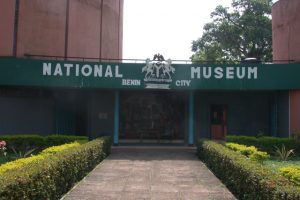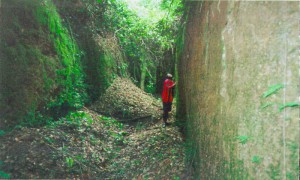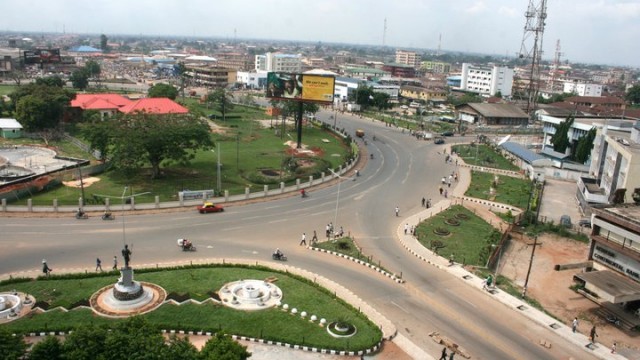Benin City has a long and bloody history. When English colonial forces first arrived in the city in 1897, they marched past a succession of disembowelled, dead, and dying people made as sacrifices to the Oba (king). They were so horrified that they ordered the destruction of Benin and sent the Oba into exile in Calabar.
Thankfully, present day Benin has very little of the violence it was once known for. Today it serves as home to roughly 1.2 million people; it’s a centre for the palm oil and rubber industries, and an important crossroads linking Lagos to the west, Warri to the south, and Onitsha to the east. The downtown area, which can be easily — and safely — explored in a day or two, offers a number of museums, markets, palaces and historical landmarks that provide a glimpse into the city’s fascinating past and dynamic present.
Orientation
The easiest way to orient yourself in Benin City is to take a bus or taxi to King’s Square the clearly defined centre of the city. From here, it’s possible to walk to many of the key landmarks. The square is actually a small park circumvented by the ever-busy ring road (the large roundabout that defines the centre of town). From this roundabout, the principal roads in Benin City radiate out like a spiderweb, criss-crossing the city. For example, to get to the airport, simply take Airport Road in the direction of the town, and it will eventually hit Ring Road (an official airport car should cost you around N2,000 to any of the major hotels).
Attractions
Start with the National Museum (entrance fee N300) based in King’s Square. It’s a circular three-story building housing many traditional Edo carvings, Benin brass, and some faded sepia pictures of Benin prior to its destruction by the British. It’s a fascinating insight into what was a highly hierarchical culture, capable of craftsmanship of world-renowned quality.

National Museum, Benin City (Courtesy of willdoherty.org)
From here, the Oba’s Palace is north west of the square; simply walk to the northwest corner and look west, and you will see the compound with a large arch announcing its presence. It’s not of real architectural interest, but it is still an important social and economic centre of the city, and a place where visiting dignitaries are received and local disputes arbitrated.
If you choose to walk, head east back across the square. The first road you encounter is Oba’s Market Road, home to one of the two main markets in Benin City. It centres around a two-story building on the left hand side of the road and spills over to several blocks on the right. It’s a buzzing, edgy market with a sense of organised chaos, frequented by travellers from neighbouring states buying and selling all manner of goods. The market is broken down into distinct sections: meat and frozen goods are mainly sold on the left hand side of the road, while household goods, books, magazines, linen, and ironmongery occupy the right. Simply browsing here may well bring suspicion, so it can be a good idea to have a fixed objective when entering the market.
From here, head back south west across the square and walk down Sakpoba Road. Igun Street will be your first left. Igun Street is a UNESCO World Heritage site and centre of the famous Benin brass production. It was established in order to support brass-making skills and workmanship, which, despite having survived for centuries, began fast diminishing in the 20th century. It has proved a successful project and although there is a lack of real tourist numbers here, there is none of the pushy salesmanship that is visible in the markets in Lagos. What’s even more interesting are the furnaces and street side workshops in which the brasses are produced. A polite inquiry and a small dash (N100-200) should allow you to watch this centuries old firing process in action. Look for the small ceremonial shrines near most workshops where the artisans leave small offerings of chicken heads or weasel tails to ensure profitable work.
From Igun Street you can either walk, or catch a local bus further along Sakpoba Road to the second of the two markets in Benin City, the Queen’s Market (Ekeosa Market). Along the way, look for St. Matthew’s Cathedral on your left, a twin-spired Anglican cathedral dating back over a century. A little further down on your left, there is a single-story mud brick building with a corrugated iron roof. Unprepossessing as it looks, it’s actually one of the last surviving structures from the old city, known as Ogiamen’s Palace. A large sign in front of it declares that it is a renovation project being undertaken by the Palace and Project Commission.
Ekeosa Market is a couple of blocks further on the left hand side and occupies a full city block. Though practically nothing is visible from the road, look for small openings in the external walls and a succession of goods-carrying shoppers, then follow their lead. Once inside it is a strange experience: neither night nor day, with wooden stalls crammed together in impossibly tight success, and goods-carrying porters rushing back and forth with bags of rice, wheat flour, and other staples. It’s not a spot for the claustrophobic. While predominantly a food market, there are also stalls selling local soap, toiletries, cosmetics, and a section devoted to traditional medicines. This section is a macabre and unsettling experience — you’ll walk past stalls selling live chickens and tortoises, as well as remnants of monkeys, cats, and crocodiles used for traditional healing (or Juju) purposes. It’s a fascinating and disorienting place, one in which stepping back into the bright lights of the street can be a welcome relief. Be careful not to touch or damage stalls as you pass, and keep your bags and possessions close at hand.

The Walls of Benin City (www.abovetopsecret.com)
Having gathered your senses, continue down to “third junction.” It borders the market on one side, and it’s a popular bus stop for those heading out of town. The only real sight of interest here is part of the 8th century wall and moat that surrounded ancient Benin City. The walls were once said to have been eight feet high in order to defend from neighbouring tribal attacks; however with no real funding for their preservation, they have been allowed to disintegrate to an alarming extent, and the moat is now filled with plastic bags and rubbish. A better example of the wall closer to it’s original condition can be seen opposite the cultural centre on Sapele Road.
Excursions
For those looking for the best view of the city, head out of town on Sakpoba Street until the road descends and crosses the Ikpoba Road, as the road climbs the other side, it reaches the peak of what is known as Ikpoba Hill. From here, it is possible to look back across the river as it snakes along a green corridor on the valley floor with the city rising on the opposite bank.
Other sites of interest in Benin City include the Benin Club, on the corner of Reservation Road and Seventh Avenue. This colonial holdover comprises tennis courts, a grand members club, and a golf course that is well maintained with impeccable greens. It is possible to play a round for roughly N10,000 (green fee N5,000, club hire N3,000, caddy N1,000). Alternatively, there is the surreal “Revelation Tourist Palazzo.“ Built in the 1980s by popular musician Victor Uwaifor, it’s a bizarre experience — part self-aggrandising litany of Uwaifor’s considerable musical and artistic talents, part cultural and historical insight into Benin’s rich and bloody history. Visitors can walk between rooms displaying either pictures and musical instruments painted and created respectively by Uwaifor. From here, they are plunged into a part Madame Tussaud’s, part show ground attraction series of exhibits in which the various horrors of slavery and later day events are commemorated with full-size sculptures in a variety of painful poses. The tour culminates in a large concrete replica of a plane that inexplicably dominates the front of the building. Highlights include a scene depicting the occasion Victor was visited by (an apparently cross-eyed) mermaid while sitting on Bar Beach in Lagos, and a model gorilla who looks to have seen things none of us could ever understand. It’s also worth asking to see Victor’s car, built entirely from separate parts shipped into Nigeria. This is truly-one-of-a-kind, bizarre, yet slightly brilliant excursion.
Dining
While there aren’t that many restaurants in Benin, one we can definitely recommend is Bamboo House. The restaurant is popular with both ex-pats and locals and serves up delicious Chinese cuisine. Specialties include delicious pork dumplings, wonton soup and Szechwan noodles. Otherwise, most of the hotels have decent food to cover your needs.
Where To Stay
While Benin City has somewhat limited places to stay compared to Nigerian cities, there are still some nice places to rest your head. For one of the best places and best locations in the city, try the Meridian Lodge. Staff at the hotel is professional, and the setting is also quite nice and located near popular destinations.
For something a bit more modern, head for the Protea Hotel Select Emotan. The hotel serves as the hub for many business meetings in the city and is only a few minutes drive from the airport. Hotels rooms are clean, and offer TV’s and free Wi-Fi (albeit a bit slow). There is a nice buffet on the premises as well serving both traditional Nigerian cuisine and continental fare.
The Excalibur Benin also offers fantastic facilities with an exceptional staff. The hotel offers banquet halls, meeting rooms, a swimming pool, pool bar, gym, and a steam room. The interior of the hotel has bright and clean decor, and the rooms also keep up the standards of the tidiness and modern design of the lobby.
Getting There And Around
Those used to the bustling disorder of Lagos will find Benin runs at a slightly slower, more orderly pace. It still has its share of ‘”go slows” (traffic jams), but nothing like the gridlock that affects large parts of Lagos on a daily basis. Local buses run up and down most of the roads emanating from King’s Square (look for minibuses with distinctive red and yellow livery), and normally won’t cost more than N30 for a short journey. Alternatively, local taxis can be hired for as little as N500 an hour, while hotel taxis will probably be around N1,500.
Safety
As with everywhere in Nigeria, it’s worth taking sensible safety precautions in Benin City. Don’t carry large amounts of currency or show it openly, and should you be carrying expensive equipment such as a camera, carry it in a bag rather than on display. All the main ATMs in the centre have armed guards and are safe to use, whereas those further away should be used with care, so as not to attract the attention of “area boys” (local youth gangs that each roam a different neighborhood).
While “oyibos” (white foreigners) do get attention while walking the streets here than in Lagos, the reaction is generally one of amusement rather than aggression. The one exception to this may be taking pictures of people, especially in the markets. Here, most will actively avoid having their picture taken, though photographing goods or stalls is fine.
Essential Links and Information:
Location: Benin City is 25 miles north of the Benin River in southern Nigeria and is the capital of Edo State.
Weather: The climate in Benin city is tropical with warm weather in the dry season, and humid rainy weather during the wet season. In high temperatures peak in June with highs around 28C/82F but get down to lows around 5C/41F in January. Unlike more inland cities in Nigeria, the weather is regulated by being close to the ocean.

